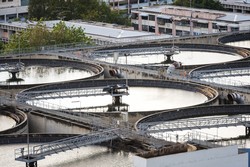Drinking water disinfection by-products: adverse outcome pathways, enrichment methods, mixture effects, mitigation strategies
The use of chemical oxidants to disinfect drinking water and eliminate pathogens can result in the formation of DBPs, which have raised public health concerns. Chlorination of drinking water, for example, can produce a range of toxic DBPs, only a small number of which have been identified and tested for their potential toxicity. Many DBPs however, are volatile and polar and cannot be easily studied using current methods. The project AQUABIOTOX (Bioanalytical evaluation, identification, and characterisation of disinfection by-products formed during drinking water treatment) was tasked with developing and evaluating techniques and bioassays for identifying DBPs. Improved extraction and bioanalytical techniques were tested with the goal to develop a screening tool that combined cell-based bioassays with chemical analysis to identify toxicologically relevant DBPs. Combining bioanalytical assessment with state-of-the-art chemical analysis will support an effect-based guidance scheme for the identification of toxic products formed during advanced water treatment processes. A set of nine in vitro cellular bioassays that reflected the different stages of the toxicity pathway were applied to 50 DBPs. The results were used to gain a clearer understanding of the molecular mechanisms behind the reactive toxicity of DBPs. In a mixture study the concentration additive effects of DBPs were demonstrated, which can be used to prioritise DBPs for further risk assessment. In addition, a fractionation process based on high-performance liquid chromatography was used to separate toxic compounds, which aimed at the chemical identification of toxic DBPs. The researchers also evaluated 10 commercial tap water filters for their ability to reduce levels of adsorbable organic halides and fluoride. It was found that activated carbon based tap water filters could provide important health benefits by removing organic compounds such as disinfection by-products, if the filters are regularly replaced. AQUABIOTOX successfully developed bio-analytical screening tools for the toxicological monitoring of treated waters, which might enable to identify toxicologically relevant DBPs in the future. This might allow relevant authorities to mitigate the effects of DBPs and ensure the best quality of water for EU citizens.
Keywords
Disinfection by-products, drinking water, AQUABIOTOX, bioassay, high-performance liquid chromatography

